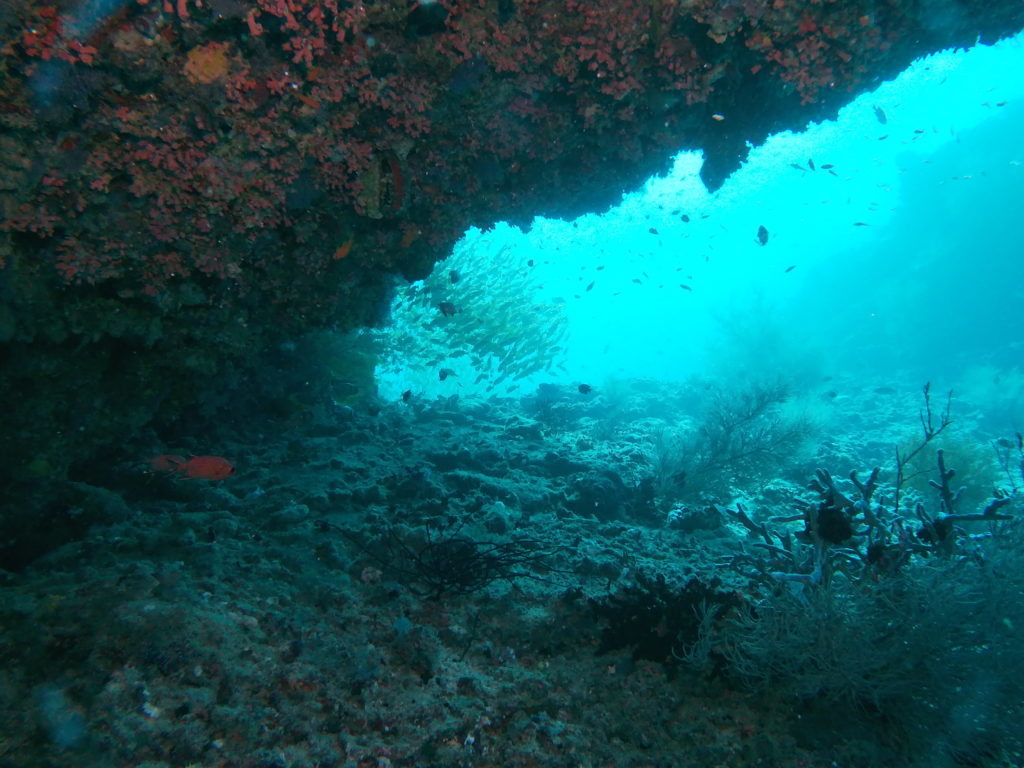There are many sites we also visit but it would be too much to list them all.
North Male Atoll;
Fish Tank / Fish Factory
This is north of the airport, every afternoon around 16:30 hrs the fish factory throws all the cut off’s from the fish processing plant and this attracts a lot of Stingrays, Sharks and Murray Eals. This is not a difficult dive site and we mostly dive it as the first dive of the trip to get all sorted out.
Kuda Haa
Kuda Haa is a thila west of Male’ and north of Giraavaru, about 60 minutes sailing. This small thila looks like camel humps. The larger of the two humps is about 30 meters in diameter with steep slopes, with the top at about 8 meters.
To the north, connected by a ridge lies the second hump. This has its top at about 15 meters
The thila provides protection to many species of reef fish: snappers, fusiliers, groupers and lionfish. Jackfish and batfish are also common. On top of the reef, there are many anemones
with their resident clownfish. This site is a Protected Marine Area.
MV Maldive Victory
The wreck of the MV Maldives Victory lies 10 minutes from Male’, south-west of the airport. This ship ran aground on Friday the 13th February 1981. It sank the next day and it sits up straight on the bottom parallel to the reef. There is a decent line from the mast to the surface where the dive boat moor. The mast top is at 12 meters and the hull sits on a sandy bottom at 35 meters. When there is not much current this is an excellent introduction to wreck diving. The wreck is easy to dive and you can swim around the deck and explore one of the 3 cargo holds.
You can still find a lot of the cargo aboard; sacs of cement, paper, bottles, etc.
The hull has attracted much fish and a lot of coral and sponges are growing on it. For the more daring divers, the wreck is great to go into and explore the different decks, be neutrally buoyant and move slowly and you will have a thrilling experience. Visit the captain’s cabin and swim up
to the bridge and exit on to the flybridge. From the top of the bridge, you will find a line back to the mast you started from. Be sure you do your safety stop on the way up.
Ari Atoll
Kuda Rah Thila
This Thila is a beauty, It can be dived by a bit more experienced divers, the dive site is in the middle of the atoll and the reef starts about 12 meters. It has an arch you can swim through and great coral and fish life. A dive you have to do.
Fish Head/Mushimasmigilly
This is one of the world’s most famous dive sites. Its steep sides are spectacular, with multi-level ledges, overhangs and caves supporting sea fans and black corals; its top is heavily encrusted with anemones. The prolific fish life includes fusiliers, large Napoleons, trevally and schools of hungry barracuda, though grey-tip reef sharks are the main attraction. The numerous sharks can be seen up close. Strong currents can make this a demanding dive, and extreme care should be taken not to damage the superb but heavily used site.
The reef top starts at 6-9 meters depth so it is a decent in the blue and when there is a current we start away from the thila and float to it.
Mayaa Thila
Another great dive, as Fish Head, also protected as a Marine Reserve by the Maldivian government. Although grey reef sharks are also quite common at Maaya Thila, the smaller white tips are the center of attention, often with dozens of them circling the reef. Maaya Thila is about 80 meters in diameter and can easily be circumnavigated in one dive – if the current is favourable – although it is not uncommon for divers to spend the entire dive in one area to digest the incredible diversity of marine life. The top starts at six meters and the reef edge drops from 12 meters to depths of 30 meters and more. So again we start in the blue..
Moofushi Manta Point
This marine protected reef on the south of Rangali Kandu starts from 2-3 meters and drops to 10 meters gradually. After 10 meters most of the reef drops vertically down to 25-30 meters.
During the northeast monsoon, there are very good chances to find mantas here, feeding on the plankton-rich water going out of the atoll. Outside of Manta season, this is still a very attractive site with a high concentration and range of life. Along the reef top, you can always find the moray, scorpionfish, octopus and large napoleon wrasse., red toothed triggerfish sometime seem to obstruct the view of the surface due to the high numbers present on this reef.
There are many cavities along with the reef and even small caves with swim-throughs.
Note that the mantas will be in the dive site only with strong currents, washing away all the plankton. Carry a safety balloon and be prepared for an open water safety stop.

















